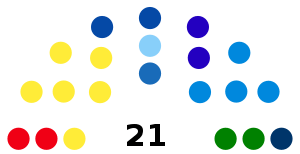Politics of Molise
 |
|---|
| This article is part of a series on the politics and government of Molise |
|
The Politics of Molise, Italy takes place in a framework of a presidential representative democracy, whereby the president of regional government is the head of government, and of a pluriform multi-party system. Executive power is exercised by the regional government. Legislative power is vested in both the government and the Regional Council.
Executive branch
The regional government (Giunta Regionale) is presided by the president of the region (Presidente della Regione), who is elected for a five-year term, and is composed by the president and the ministers (Assessori), who are currently 8.[1]
List of Presidents
| President | Party | Period | |
|---|---|---|---|
| I Legislature | |||
| Carlo Vitale | DC | 1970–1973 | |
| Giustino D'Uva | DC | 1972–1975 | |
| II Legislature | |||
| Florindo D'Aimmo | DC | 1975–1980 | |
| III Legislature | |||
| Florindo D'Aimmo | DC | 1980–1982 | |
| Giustino D'Uva | DC | 1982–1984 | |
| Ulderico Adolfo Colagiovanni | DC | 1984–1985 | |
| IV Legislature | |||
| Paolo Nuvoli | DC | 1985–1988 | |
| Fernando Di Laura Frattura | DC | 1988–1990 | |
| V Legislature | |||
| Enrico Santoro | DC | 1990–1992 | |
| Luigi Di Bartolomeo | DC | 1992–1994 | |
| Giovanni Di Giandomenico | DC | 1994–1995 | |
| VI Legislature | |||
| Marcello Veneziale | The Olive Tree | 1995–1998 | |
| Angelo Michele Iorio | FI | 1998–1999 | |
| Marcello Veneziale | The Olive Tree | 1999–2000 | |
| VII Legislature | |||
| Giovanni Di Stasi | The Olive Tree | 2000–2001 | |
| VIII Legislature | |||
| Angelo Michele Iorio | FI | 2001–2006 | |
| IX Legislature | |||
| Angelo Michele Iorio | FI | 2006–2011 | |
| X Legislature | |||
| Angelo Michele Iorio | PdL | 2011–2013 | |
| XI Legislature | |||
| Paolo di Laura Frattura | PD | 2013–2018 | |
| XII Legislature | |||
| Donato Toma | FI | 2018–present | |
Legislative branch
The Regional Council of Molise (Consiglio Regionale del Molise) is composed of 30 members. 24 councillors are elected in provincial constituencies by proportional representation using the largest remainder method with a Droop quota and open lists, while 6 councillors (elected in bloc) come from a "regional list", including the president-elect. One seat is reserved for the candidate who comes second. If a coalition wins more than 50% of the total seats in the council with PR, only 3 candidates from the regional list will be chosen and the number of those elected in provincial constituencies will be 26. If the winning coalition receives less than 40% of votes special seats are added to the council to ensure a large majority for the President's coalition.[2]
The council is elected for a five-year term, but, if the President suffers a vote of no confidence, resigns or dies, under the simul stabunt, simul cadent clause introduced in 1999 (literally they will stand together or they will fall together), also the Council is dissolved and a snap election is called.[3]
Parties and elections
Latest regional election
 | |||||||||
| Candidates | Votes | % | Seats | Parties | Votes | % | Seats | ||
|---|---|---|---|---|---|---|---|---|---|
| Donato Toma | 73,229 | 43.46 | 1 | ||||||
| Forza Italia | 13,627 | 9.38 | 3 | ||||||
| Pride Molise | 12,122 | 8.34 | 2 | ||||||
| League | 11,956 | 8.23 | 2 | ||||||
| Populars for Italy | 10,351 | 7.12 | 2 | ||||||
| Union of the Centre | 7,429 | 5.11 | 1 | ||||||
| Brothers of Italy | 6,461 | 4.45 | 1 | ||||||
| Iorio for Molise–Us with Italy | 5,204 | 3.58 | 1 | ||||||
| National Movement for Sovereignty | 3,924 | 2.70 | – | ||||||
| The People of Family | 603 | 0.41 | – | ||||||
| Total | 71,677 | 49.32 | 12 | ||||||
| Andrea Greco | 64,875 | 38.50 | 1 | Five Star Movement | 45,886 | 31.57 | 5 | ||
| Carlo Veneziale | 28,818 | 17.10 | – | ||||||
| Democratic Party | 13,122 | 9.03 | 2 | ||||||
| Free and Equal | 4,784 | 3.39 | – | ||||||
| Molise 2.0–Democratic Centre | 3,459 | 2.38 | – | ||||||
| Union for Molise | 3,233 | 2.22 | – | ||||||
| Molise of All | 2,716 | 1.87 | – | ||||||
| Total | 27,314 | 18.79 | 2 | ||||||
| Agostino Di Giacomo | 707 | 0.42 | – | CasaPound Italy | 477 | 0.33 | – | ||
| Total candidates | 167,629 | 100.00 | 2 | Total parties | 145,354 | 100.00 | 19 | ||
| Source: Region of Molise. | |||||||||